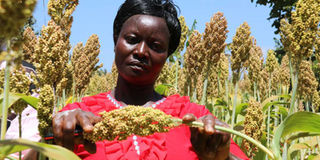Ask your Agronomist: Your sorghum yield should grow if you follow this fertiliser regime

Catherine Wanja, a sorghum farmer in Embu County samples the sorghum crop planted in her farm which is used as a demonstration plot, during a past farmers' field day. Sorghum can tolerate drought conditions better than other crops due to its well developed roots and small leaf surface area which has a waxy layer and folds inwards during high temperatures to reduce transpiration. FILE PHOTO | NATION MEDIA GROUP
What you need to know:
- Sorghum requires deep well drained fertile soils.
- Sorghum can tolerate drought conditions better than other crops due to its well developed roots.
- Topdressing fertiliser should be applied when the crop is knee-high.
- Production for sorghum varies with variety ranging from 8T for Gadam and 12t for Serena.
Q: I have been growing sorghum for the past two years but my production has been really low. I have tested my soils and results show I have good soils for sorghum but production is below 1,000kg per acre. Please help me improve my production.
Kennedy Magambo
Thanks for your enquiry, Mr Magambo. Sorghum is slowly becoming a crop of interest due to the fact that it can adapt very well in many regions of Kenya.
Sorghum can be used as food (either as grain or flour) or for brewing beer. The two are the driving force of many farmers adapting sorghum in Kenya, and the returns are good when production is equally great.
Now that we have farmers who are thinking agri-business and looking at making money from sorghum cultivation, we can now look slightly deeper into sorghum production.
What nutrients are key in sorghum production, and is fertiliser use in sorghum production important?
Growth Requirements
Sorghum requires deep well drained fertile soils. This will enhance root growth and expansion for better uptake of moisture in the soil, the best soil pH being 5.4 – 8.4.
Seedings should be done when soils are moist enough to enhance uniform germination.
High temperatures do affect flower initiation and development, which in turn affects overall sorghum production.
Sorghum can tolerate drought conditions better than other crops due to its well developed roots and small leaf surface area which has a waxy layer and folds inwards during high temperatures to reduce transpiration.
Fertiliser Requirements
For optimal yields, it is important to understand the requirements of the crop. Sorghum requires several key nutrients for maximum productivity.
These are Nitrogen(N), Phosphorus(P), Potassium(K), Sulphur(S), Magnesium(Mg), Zinc (Zn), Calcium(Ca) and to some extend Manganese(Mn) and Copper(Cu).
Farmers should apply NPK fertiliser with at least six combinations of the above nutrients (including the NPK) for maximum production.
NPK fertilisers with ratios (N=20-24, P=9-11.5, K=4.5-7) including S, Mg, and Zn give the best combination ratio for sorghum production.
Fertiliser application for NPK is best done in two splits for better yield production. The recommendation would be to do a rate of 75kg per acre at planting and 50kg per acre at topdress.
Topdressing fertiliser should be applied when the crop is knee-high.
In every crop planted, please ensure you use certified seeds and follow good agricultural practices in order to realise maximum benefit of investing in high quality fertiliser.
Production for sorghum varies with variety ranging from 8T for Gadam and 12t for Serena.
I wish you the best as a farmer and please invite me for a cup of uji made from sorghum after the harvest.
For crop specific fertiliser recommendations, please consult the following agronomists in your area:
Western and Nyanza, Daniel Mui, 0702466343.
Rift Valley, Dennis Nyandaya, 0702466372.
Central, Robert Ngatia, 0702466318.
-Peter Wekesa, Senior Agronomist, Yara




